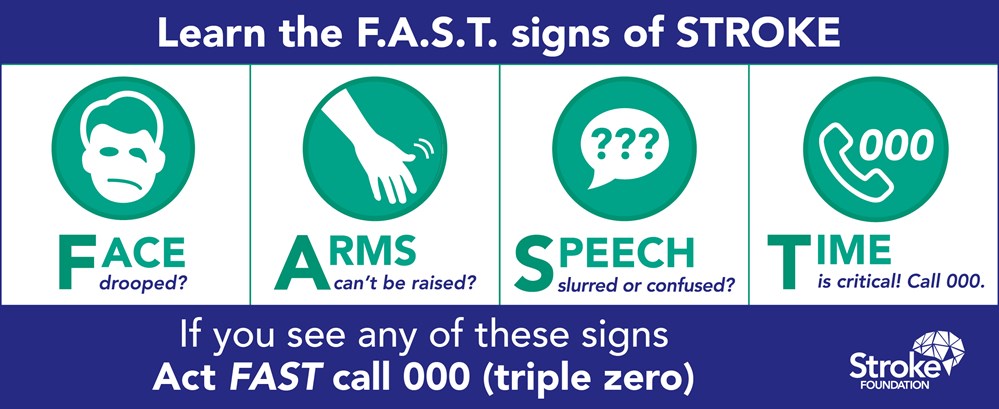Signs of stroke
English Arabic (العربية) Chinese - Traditional (繁體中文) Chinese - Simplified (简体中文) Greek (Ελληνικά) Hindi (हिन्दी) Italian (Italiano) Korean (한국어) Vietnamese (Tiếng Việt)

How do you know if someone is having a stroke? Think… F.A.S.T.
The Stroke Foundation recommends the F.A.S.T. test as an easy way to remember the most common signs of stroke. Using the F.A.S.T. test involves asking these simple questions:
- Face Check their face. Has their mouth drooped?
- Arms Can they lift both arms?
- Speech Is their speech slurred? Do they understand you?
- Time Is critical. If you see any of these signs call 000 straight away.
Download F.A.S.T. Image Poster
Think F.A.S.T., act FAST
A stroke is always a medical emergency. The longer a stroke remains untreated, the greater the chance of stroke-related brain damage.
Other signs of stroke
Facial weakness, arm weakness and difficulty with speech are the most common symptoms or signs of stroke, but they are not the only signs.
The following signs of stroke may occur alone or in combination:
- Weakness or numbness or paralysis of the face, arm or leg on either or both sides of the body
- Difficulty speaking or understanding
- Dizziness, loss of balance or an unexplained fall
- Loss of vision, sudden blurring or decreased vision in one or both eyes
- Headache, usually severe and abrupt onset or unexplained change in the pattern of headaches
- Difficulty swallowing
Sometimes the signs disappear within a short time, such as a few minutes. When this happens, it may be a transient ischaemic attack (TIA). After a TIA, your risk of stroke is higher. Stroke can lead to death or disability. A TIA is a warning that you may have a stroke and an opportunity to prevent this from happening.
If you or someone else experiences the signs of stroke, no matter how long they last, call 000 immediately.
What to do while you wait for an ambulance
Emergency medical treatment soon after symptoms begin improves the chance of survival and successful rehabilitation.
